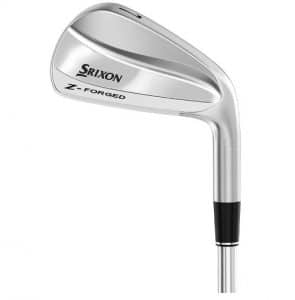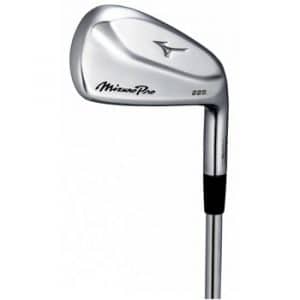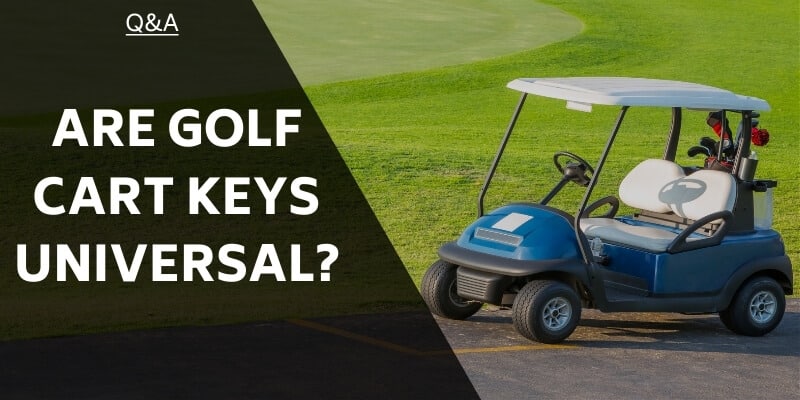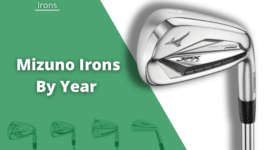To put it simply, forged irons have a club head that is pressed and milled from a single piece of metal, while cast irons are constructed using molten metal and a cast. Forged clubs are usually better for low handicap players.
On the other hand, cast irons can use cavity backing and perimeter weighting to make them more forgiving, which makes them ideal for new players or those with a higher handicap.
There is a major difference between cast and forged irons is the construction and materials used. Forging of steel has been around for centuries and was the accepted way for golf iron manufacture any time before the 1980s. Let’s take a more detailed look at forged vs. cast irons.
Forged vs. Cast Irons
| Forged Irons | Cast Irons | |
| Pros |
|
|
| Cons |
|
|
Forged Golf Irons
Some of the Best Forged Irons
How They Make Forged Irons for Golf
The basic technique is to heat steel, usually a bar of 1025 or 1025E steel, to a red-hot temperature. Depending on the club being made, the steel is heated and then bent to the required angle. It is then placed in a primary forging mold where an air hammer press produces the basic shape.
The excess metal from around the edges is trimmed off by another machine and is then reheated. The metal is now placed into a second mold and slowly pressed to its final shape, including the grooves. The sides of the clubhead are then smoothed on a grinder and finally polished and electroplated, usually in chromium-nickel, before being attached to a shaft.
Benefits of Forged Golf Clubs
Forged irons provide better feedback to the user than cast irons. This is because the vibrational impact upon the strike of the ball is stronger from the milled club.
Using forged irons will help users become better golfers as they are less forgiving and therefore require more consistent swings to maintain a low score on the course. Yet, this could also be interpreted better as a negative for a weekend warrior golfer.
Cavity-backed varieties of forged irons are becoming more readily available, which decreases the forgiveness gap between the two styles of irons.
Read More: The Best Forged Irons
Cast Irons for Golf
| Cleveland Golf Launcher Turbo HB | LAZRUS Golf Irons | Callaway Golf Rogue ST Max |
|
|
|
How They Make Cast Irons
The construction of the cast cavity-backed irons with perimeter weighting, also known as ‘game improvement irons’, consists of molten metals or alloys being cast into a mold. This is a much easier and cheaper method of manufacture.
Ping is often credited for the early developments in cavity-baked irons, although, interestingly, their first club with this feature was a putter. Ping continued with this “new” technology and competitors soon followed.
Benefits of Cast Irons
Every golfer is looking for accuracy, which is mostly determined by the clubhead’s Center of Gravity (CG). Another way of expressing the C of G is the ‘Sweet spot’.
Missing the sweet spot produces shots that fly off course, either slicing or hooking and can also result in a loss of distance. The need to eliminate this tendency to spray the ball in various directions, other than that intended, is what led to the development of the cavity-backed clubhead.
The weight is now removed from the middle of the clubhead and distributed around the edges of the face resulting in a much larger sweet spot. This, in turn, results in greatly improved forgiveness which is a massive help, especially for beginners and high handicappers.
Forged irons, by contrast, are solid chunks of steel with the weight more evenly spread but concentrated at the back and middle. This results in a much smaller sweet spot or center of gravity.
These clubs are usually of the blade design and are also known as ‘muscle backed’.
The solid steel construction of the forged iron has a softer feel than the cast clubs, and for the low handicap player or professional, this degree of feel is significant. A high handicap player would probably not be able to notice the difference and would get better results from the cast cavity-backed clubs.
Who Should Use Cast Irons and Who Should Use Forged Irons
Although there are exceptions to this rule, it’s generally accepted that forged irons are better suited for low handicap players, and forged clubs suit those that need extra forgiveness. However, as cavity-backed forged irons become more popular, everyday golfers can get the best of both worlds. So with that it mind, it becomes a question of budget more so than player experience. You get a lot more club for the price by opting for cast irons but will lack the superior feedback of a set of forged irons.
Cast vs Forged Irons: What the Pros Use
The technological evolution to cast irons started in the eighties, and by the mid-1990s, almost half the PGA pros tour were still using forged irons. Fifteen years later, this percentage was back up to eighty percent. There are probably two reasons for this move back to forged irons and away from cast options.
Many players felt that playing with the cast irons, with the ‘game improvement’ benefits of the cavity back and larger, more forgiving sweet spot, could lead to sloppiness. Getting used to the forgiveness, you tend to not be too concerned about hitting a sweet solid shot, and if this habit transfers to the driver, you are looking for trouble.
Secondly, the manufacturers could borrow from the cast irons’ technology and produce forged irons with cavity backs, thus providing the best of both worlds.
Feel and control were other factors many pros preferred with forged irons.
Professionals and purists prefer to stick to the traditional, and the challenge is perfection. Being able to consistently hit the smaller sweet spot results in greater feel, being able to shape the ball, and getting your distances accurate.
Speaking of tradition, many better players prefer the look and significance of using more traditional forged irons.
Forged Irons vs Cast Irons: Are Forged Irons Better?
It all depends on the player and their skill level and whether golf-forged irons suit them better.
There are many arguments for and against cast vs forged golf clubs, and it could be difficult to distinguish between myth and fact. Here’s our take on the most common arguments for forged irons.
Forged Irons Are for Better Players
Generally, this could be true, as the forged iron with a smaller sweet spot is not as forgiving. With the advances in technology and club design, this distinction is becoming more blurred as cavity-back forged irons enhance forgiveness.
When looking at sales numbers, forged irons range between 10 to 15 percent, with the balance being cast irons. This does not determine which is better, only that more players choose cast irons’ forgiveness and modern design. It also shows that fewer players are in the scratch handicap range.
Forged Clubs Feel Softer
A very difficult thing to measure and quantify; only the top players would really be able to ‘feel’ any difference. Testing has proved that feel comes more from the geometry of the club than from the material.
It is true that when you consistently hit the sweet spot with a forged iron it is such a ‘sweet’ feeling. Hit it off-center it will talk to you, and you will see some ugly hooks and slices.
It Is Easier to Shape the Ball Flight With Forged Irons
As with the feel above, this has more to do with the design than the material. The head shape and the weighting places the C of G closer to the face. The better player will get great results from solid shots but get burnt with mishits. The cast irons with a lower and deeper C of G and a larger sweet spot reduce the negative effect of a mishit, tending to straighten out the ball flight.
Read More: The Most Forgiving Irons
Forged vs. Cast Wedges
You can apply the same logic to wedges as you do with irons. Forged wedges have better feedback and are generally less forgiving. They are also usually more expensive than an equivalent cast wedge.
The Main Differences Between Forged and Cast Irons
- They are constructed differently.
- Forged Irons are more workable.
- Cast irons have perimeter weighting for a larger sweet spot.
- Forged irons are damaged more easily.
- Cast irons are usually much cheaper.
FAQ
Which Is Better Cast or Forged Irons?
Forged irons are usually better for more experienced golfers, while cavity-backed cast irons suit high handicap players.
Are Cast Irons More Forgiving Than Forged?
Cast irons usually have a larger sweet spot and lower center of gravity with perimeter weighting, making them more forgiving.
Do Professionals Use Forged Irons?
The majority of PGA pros use forged irons, but there are still many that use cast irons too.
Can High Handicappers Use Forged Irons? / Are Forged Irons the Better Choice for Beginners?
If you plan to practice a lot, forged irons could be a better choice as they will help you to become a better player in the long run. If you just playing occasional weekend golf, you’re better off with cavity-backed irons. They can still be forged, but cast irons are usually cheaper and more forgiving.
Are Forged Irons Harder to Hit?
Generally speaking, forged irons are a little harder to hit as they have a smaller sweet spot and higher CG.
What Does Forged Mean in Golf?
Forged irons mean that the clubhead was built from a single solid piece of metal.
Cast Irons vs. Forged Irons – Final Thoughts
Market sales tend to prove that cast is more popular when you compare forged vs cast irons, so what are the advantages of forged irons?
If you are an above-average athlete with a proven golf ability, then you want to be the best you can be. The best in the game, the top 10 percent, and the pros mostly play with forged irons.
We do not all fall into this category; therefore, we have to decide what will work best for our game. A weekend warrior or high-handicap golfer will become frustrated with most forged irons, particularly blades.
With forged irons, learning the discipline to consistently hit this smaller sweat spot, to improve your control over the shape of the shot and the distance will greatly enhance your enjoyment and reward from the game.
Provided you have the skills and experience, there is no question that you will feel with the purists that forged is the way to go.
Nick is the founder of GolfSpan and an avid golfer. He's not quite a pro but has over 15 years of experience playing and coaching golfers worldwide. His mission is to bring the golfing community a better experience when it comes to choosing the right golf gear and finding the right setup for your game.








